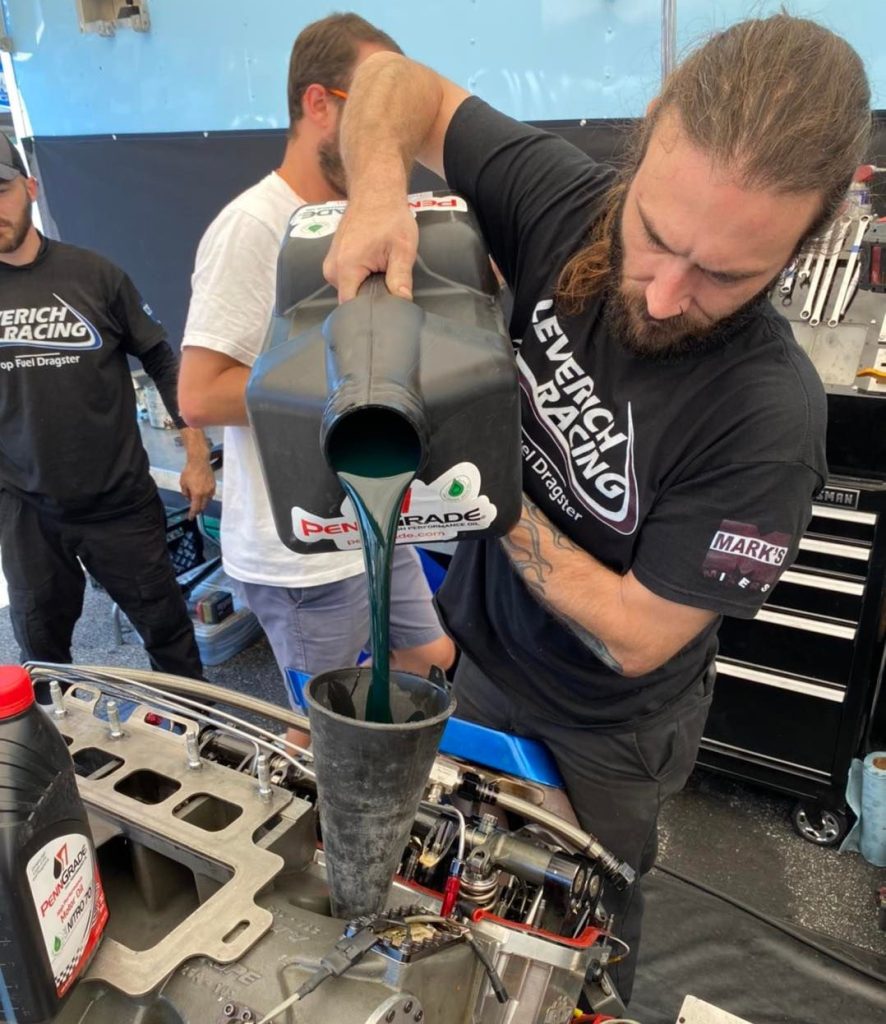Plenty of racers and performance engine builders fondly recall the “Green Oil” that rose to fame during the 1970s. Prized for its impressive lubrication qualities and durability in a high-stress engine environment, the oil was easy to spot at dragstrips and racetracks across the country thanks to its distinctive greenish tint.
Though it has changed hands a few times over the years, the proprietary Green Oil formulation is now sold under the name PennGrade 1 out of Lebanon, Indiana—where the company continues to produce this coveted synthetic-blend motor oil (along with plenty of other high performance lubricants).
And our pal Nick Dixon from PennGrade 1 has been part of that Green Oil oil legacy for decades, so he knows an awful lot about the lubrication demands of a high performance racing engine.
So OnAllCylinders Managing Editor David Fuller sat down with him for an episode of The OnAllCylinders Podcast, where the two spent considerable time talking about general engine oil tech topics. You can catch the full interview in the embedded player here, and we’ll include some excerpts from the conversation below too.
***
***

General Engine Oil Q&A with Nick Dixon from PennGrade 1
***
Why Does This Oil Have Such a Distinctive Green Color Tint?
“If you’re in the Pennsylvania, Ohio, or West Virginia oil fields where this oil was first discovered, if you go to some of the wells that are pumping the crude oil out of the ground, the color of some of the crude oil is green.
“There are lighter greens, darker greens, ambers—but a lot of the Pennsylvania grade crude oil is green in nature. So when that raw crude oil goes through the refining process, one of the cuts that comes off of that big high distillation tower is that unique base oil that [we] use in this formulation.
“If you look at the color of that unique cut, it is almost fluorescent green, and when you put in all the additives and enhancement with the formulation, it actually gets to be that dark, rich green color.”
What Are Some Misconceptions That You Often Hear About Motor Oil?
“Most of the time, it’s ‘All oil is the same.’
“Yeah, the consumers, the racers, a lot of them think ‘Oh, any oil will work in my application. I can go anywhere and buy a quart of oil, pour it in, and I’m set to go.’
“But unfortunately, with today’s engines and all the technology and the advancements, it’s not that easy.”
Why is Using Special Break-In Oil So Important?
“You know, the break in oil, when somebody is building a brand new engine, refreshing an engine or putting in a new cam or crank—all those components have to, what we call, ‘match.’
“Let’s say you put a new engine together and you got your new piston rings on. We want to have a conformity, we want those piston rings to conform to the cylinder wall—we do that by actually wearing in that ring to the cylinder wall under a controlled environment with a break-in oil.
“At the same time, you’re getting the cam lobes to match your lifters. So with a break-in oil, it helps that conformity. It’s got the right additives in it to protect the engine—anti-wear components and the proper amount of detergents and dispersants.”
How Long Should You Leave Break-In Oil in a New Engine?
“Always defer to your engine builder or OEM for the proper guidelines.
“That being said, with our 60 year plus history and talking to thousands of engine builders, if you’re putting your engine on a dyno and you’re just starting to break it in—anywhere from 35 to 45 minutes will accomplish the break in.
“Or let’s say you’ve put your engine together and you drop it in your 1957 Bel Air, then it’s anywhere from 150 to 250 road-driven miles.
“There are a couple things you can do to check to make sure your engine is properly broken in. A lot of the builders do a leakdown test or a compression test after that engine has been broken in. That way, they’re assured that they have good piston and cylinder wall seat, and the cam is run-in.
“Once that’s done, then it’s very critical to change that oil out because you have foreign particles in it and other natural combustion byproducts. Then you would go ahead and put your everyday running oil in a brand new filter.”
What’s Changed With Oil Formulations?
“Years ago, the government mandated a reduction of zinc and phosphorus in engine oils. And the purpose of that was to protect the catalytic converters on the new cars, because the zinc phosphorus package could possibly damage your catalytic converter if you burned oil.
“Once that happened, all hell broke loose in our industry because all the guys with the classic high performance engines all started to experience cam failure.
“It’s just not the flat tappet cams either, because we found out by talking to cam manufacturers and engine builders, they also started to see some premature wear on roller cams because of the lack of the zinc phosphorus additive package.”
Why is Zinc (ZDDP) Such a Big Deal in Oil?
“Not to get too technical in the weeds here, but the ZDDP, the zinc phosphate, it reacts with the metal surfaces under pressure and temperature in your engine.
“And basically what it does is it forms a protective coating. The zinc phosphate forms a sulfide on the metal surfaces. And that acts as your anti-wear material—that’s the product that actually gets scraped off, not your metal.
“Your Z package is your artificial goat to save your components where you’re going to have the metal-to-metal contact. That package acts as your protector and it actually wants to cling to metal surfaces because of the natural polarity of the product.”
Can You Explain What Those Basic Viscosity Numbers Mean?
“Let’s just take a typical 10w30. Everybody’s heard of it. They always say, ‘well ten weight motor oil, ten weight 30.’
“Well actually the W is not considered weight—that lower number of your multi-viscosity oil, that ‘W’ stands for ‘winter.’
“We want to make sure that a 10w30 engine oil flows at a certain temperature, let’s say in the winter time, so you don’t starve that oil pump. And that was one of the key things when the first multi-viscosity oils came out. It’s basically an all-season engine oil.
“We used to switch between, let’s say a 30 weight in the winter to a 40 weight in summer.
“People don’t understand that everything is based off of the viscosity, and that’s where your engine builder and your OEM comes in. Because again they set or mandate the clearances of their bearings. You have to have the proper oil viscosity so it works properly with your OEM or engine builder. And they have all that information, what they set their clearances to and all the testing they’ve done.”
Talk About Some Distinctions Between Synthetics & Blends.
“There are applications for a full synthetic lubricant. And one of the things I’ll point to is a rear end application—let’s just say a NASCAR rear end. There, a full synthetic lubricant for that rear end differential is better than a mineral based product. We’ve shown it and we’ve seen it. That synthetic gear oil does help reduce overall temperature and gives you better longevity of the gears and the equipment.
“Now, motor oil, is there always a need for a full synthetic compared to a synthetic blend like our PennGrade 1? We found out from all of our experience that the synthetic blend that we manufacture gives the end user the best of both worlds.
“We use a very little small component of a synthetic base stock. In that formulation, I’m going to say maybe 92 to 95% is our mineral base, 78% could be our synthetic stock that we blend with it very small amount.
“And the reason we’ve done that—and we’ve seen the results—is it helps the end user on a couple of points.
“One, I like to call it full fluid flow at startup. You’re in winter and it’s 25 degrees below zero. Go out there and you turn that car over. You want that oil to get up to that top end as fast as possible? Well, with that PennGrade 1 synthetic blend, we have that little bit of synthetic material that helps ensure that full fluid flow. So you’re getting all that fluid right to that oil pickup and then getting it right up top to the engine.
“The other 92% is that unique base coat of mineral based product. Once your engine is up to temperature and is flowing, now you have that full film strength with that mineral based product.
“So yeah, I’m a firm believer in a synthetic blend, gives you a lot of benefits, keeps the price down, but gets you the performance of the full synthetic with our formulation.”
What’s the “Secret Sauce” in the PennGrade Formulation?
“Our R&D guys spent many, many, many, many months and years formulating and perfecting that product. By doing that, everybody wants to know ‘What’s your parts per million zinc and phosphorus, you know, how much do you have in that oil?’
“Well, we have no bones about telling people this: We have 1,500 parts per million zinc in about 1,400 parts per million phosphorus in our formulations.
“Others have said ‘Oh, well, we’ve got 2,000.’
“Okay. You got 2,000. But we have to remember there’s only so many internal surfaces into those engines. And we’ve talked about this before—that package of zinc phosphorus wants to pair to metal surfaces.
“Well, once you get it all coated with the zinc phosphorus, where’s the rest of it?
“It goes to the bottom of the crank. And what happens then? You know, possibly with the byproducts of combustion, it mixes with that additive package that isn’t adhering. It starts an acidic reaction and now you start to get some acid buildup in the engine.
“Metal does not like acid, and that’s what we say. We have a blended performance package. It all has to work together. Over our years and years of history, we know that’s the perfect amount to give all the protection to our customers that we need.”
***
You can catch the full interview in The OnAllCylinders Podcast section, where you’ll also find dozens of other episodes featuring famous celebrities, friendly gearheads, industry veterans, and really (REALLY) smart technical experts.

Comments